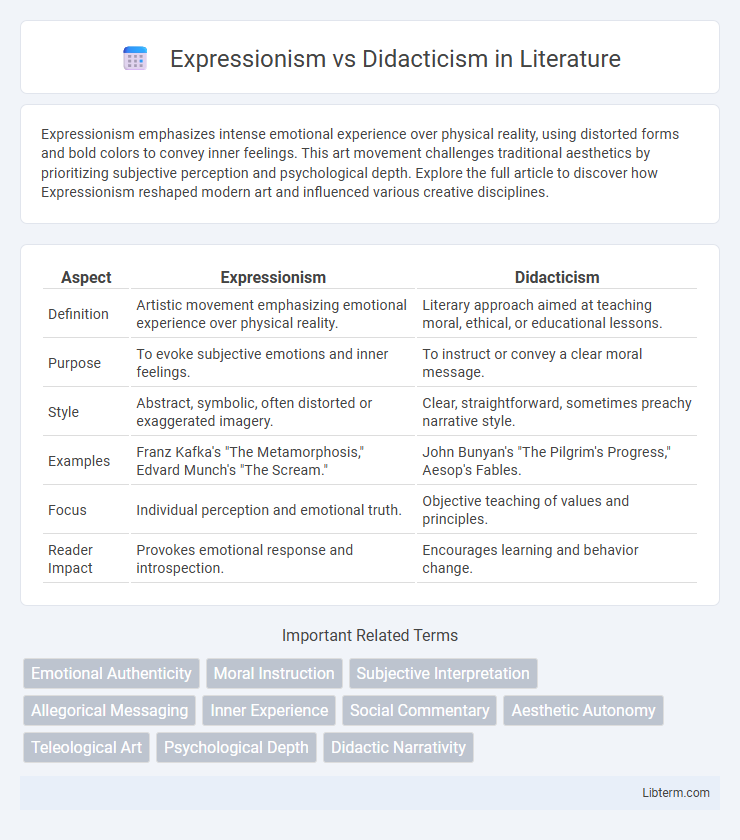Expressionism emphasizes intense emotional experience over physical reality, using distorted forms and bold colors to convey inner feelings. This art movement challenges traditional aesthetics by prioritizing subjective perception and psychological depth. Explore the full article to discover how Expressionism reshaped modern art and influenced various creative disciplines.
Table of Comparison
| Aspect | Expressionism | Didacticism |
|---|---|---|
| Definition | Artistic movement emphasizing emotional experience over physical reality. | Literary approach aimed at teaching moral, ethical, or educational lessons. |
| Purpose | To evoke subjective emotions and inner feelings. | To instruct or convey a clear moral message. |
| Style | Abstract, symbolic, often distorted or exaggerated imagery. | Clear, straightforward, sometimes preachy narrative style. |
| Examples | Franz Kafka's "The Metamorphosis," Edvard Munch's "The Scream." | John Bunyan's "The Pilgrim's Progress," Aesop's Fables. |
| Focus | Individual perception and emotional truth. | Objective teaching of values and principles. |
| Reader Impact | Provokes emotional response and introspection. | Encourages learning and behavior change. |
Introduction: Defining Expressionism and Didacticism
Expressionism is an artistic movement emphasizing emotional experience and subjective interpretation, characterized by distortion and vivid imagery to convey inner feelings. Didacticism prioritizes instructional or moral messages, aiming to educate or inform the audience through clear, purposeful communication. Both approaches contrast in intent, with Expressionism focusing on emotional resonance and Didacticism on imparting knowledge or ethical lessons.
Historical Origins and Development
Expressionism emerged in early 20th-century Germany as a reaction against realism and naturalism, emphasizing emotional experience through distorted visuals and vivid colors to convey subjective perspectives. Didacticism, rooted in classical antiquity, developed as an artistic and literary approach designed primarily to instruct and impart moral lessons, often prioritizing clarity and straightforward narratives over emotional nuance. While Expressionism evolved alongside modernist movements challenging traditional forms, Didacticism remained anchored in ethical teaching, influencing educational and religious art throughout history.
Key Characteristics of Expressionism
Expressionism emphasizes intense emotional experience through distorted forms, bold colors, and exaggerated lines to convey subjective reality rather than objective facts. It prioritizes individual perspective, emotional depth, and psychological complexity, often using abstraction and symbolism to evoke mood and inner turmoil. Unlike didacticism, which aims to instruct or moralize, expressionism seeks to provoke emotional response and introspection through visceral, often unsettling imagery.
Core Features of Didacticism
Didacticism centers on clear, instructional content designed to teach moral, ethical, or practical lessons, often prioritizing explicit guidance over artistic ambiguity. Core features include a focus on clarity, direct communication, and the promotion of specific values or knowledge, ensuring the audience comprehends the intended message without interpretive complexity. Unlike Expressionism, which emphasizes emotional experience and subjective interpretation, didactic works serve educational purposes grounded in rationality and straightforwardness.
Influential Works and Artists
Expressionism, characterized by artists like Edvard Munch and Egon Schiele, emphasizes emotional experience through distorted forms and vivid colors, with key works such as Munch's "The Scream" and Schiele's provocative self-portraits. Didacticism prioritizes moral or instructional content, seen in the works of artists like Jacques-Louis David, whose "The Death of Marat" conveys political messages and social ideals. Both movements impact art history significantly, with Expressionism focusing on subjective emotional intensity and Didacticism on clear moral or educational narratives.
Expressionism in Literature and Art
Expressionism in literature and art emphasizes conveying emotional experience over physical reality, often through distortion, exaggeration, and vibrant colors to evoke moods and ideas. This movement prioritizes subjective perspective, aiming to reveal the inner feelings and anxieties of the human psyche. Unlike Didacticism, which seeks to instruct or moralize, Expressionism centers on creating visceral, emotional impact rather than delivering explicit lessons or social commentary.
Didacticism in Literature and Art
Didacticism in literature and art prioritizes instructing or conveying moral, ethical, or educational messages, often using clear, straightforward narratives and symbolism to ensure accessibility and comprehension. This approach contrasts with Expressionism, which emphasizes emotional experience and subjective interpretation through abstract or distorted forms. Didactic works frequently serve social or political purposes, aiming to reform or enlighten audiences by embedding lessons directly within the artwork or text.
Audience Engagement and Emotional Impact
Expressionism captivates audiences through vivid emotional experiences and abstract visuals that provoke personal interpretation, intensifying emotional impact. Didacticism engages viewers by presenting clear moral lessons or educational content, fostering intellectual reflection and guided understanding. Expressionism often evokes deep emotional resonance, while didacticism prioritizes cognitive engagement and persuasive communication.
Criticism and Debates: Expressionism vs Didacticism
Criticism of Expressionism often highlights its emphasis on emotional intensity and subjective experience, which can obscure clear moral or educational messages, contrasting with didacticism's focus on instructive content and ethical clarity. Debates between proponents of Expressionism and Didacticism center on the purpose of art, with Expressionists arguing for artistic freedom and emotional depth, while didactic advocates prioritize social or moral instruction. This ongoing discourse reflects divergent views on whether art's primary role is to evoke personal reflection or convey explicit lessons.
Conclusion: Lasting Influence and Relevance
Expressionism's lasting influence lies in its ability to evoke emotional depth and subjective experience, shaping modern art, literature, and theater with its vivid imagery and introspective themes. Didacticism remains relevant through its focus on moral and educational messages, often guiding readers or audiences toward ethical reflection and social awareness. Together, these approaches continue to impact cultural production by balancing emotional resonance with purposeful instruction.
Expressionism Infographic

 libterm.com
libterm.com